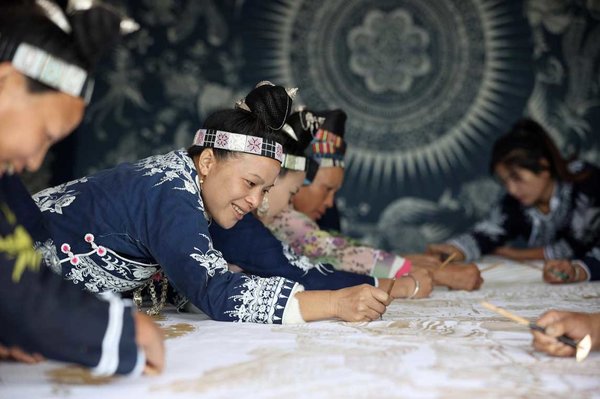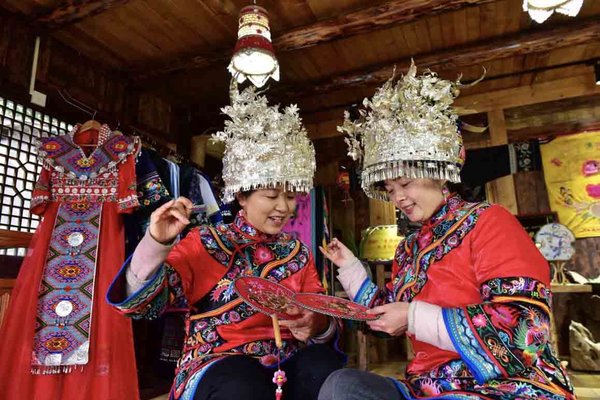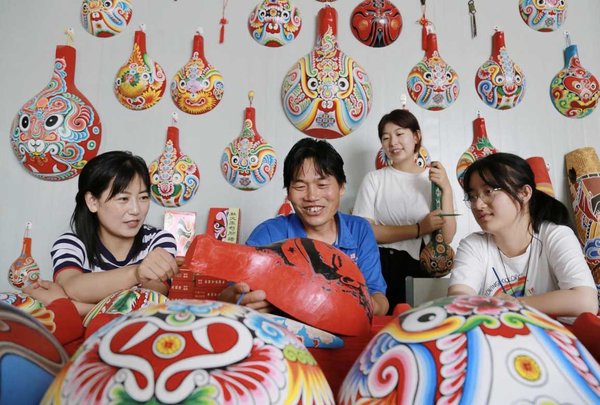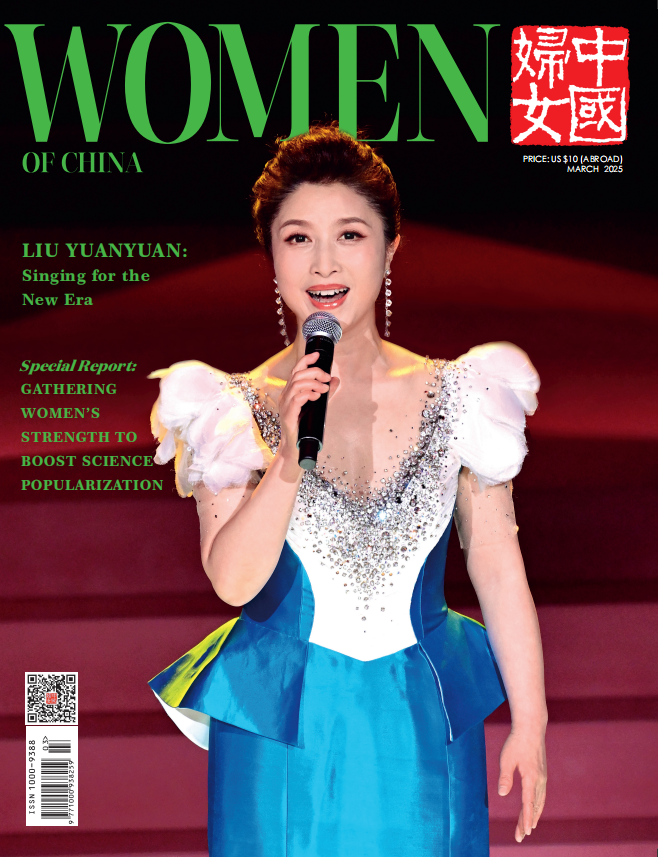Intangible Cultural Heritage Contributes to China's Rural Vitalization
 |
| Women of Miao ethnic group make batik products in a poverty-alleviation batik workshop in Danzhai County, southwest China's Guizhou Province, Oct. 7, 2022. Batik is a local intangible cultural heritage in the province. [Photo by Huang Xiaohai/People's Daily Online] |
Intangible cultural heritage constitutes an important part of the fine traditional Chinese culture and plays a vital role in promoting the market economy, integrating culture and tourism, assisting poverty alleviation and boosting rural vitalization.
Since 2021, China's Ministry of Culture and Tourism, together with other departments, has worked to assist rural vitalization with intangible cultural heritage.
So far, the country has established over 2,500 intangible cultural heritage workshops that are engaged in more than 1,700 intangible cultural heritage items of different levels. In particular, 1,400 of these workshops are located in regions that have shaken off poverty, helping promote local employment and increase people's income.
Xiaoshiquan Village in Yinping Township, Yicheng District, Zaozhuang, east China's Shandong Province has set up an intangible cultural heritage workshop of fenpi, a type of sheet jelly made of sweet potatoes. The typical Chinese food is a provincial-level intangible cultural heritage of Shandong Province.
So far, the workshop has launched over 300 training sessions on fenpi making. With this workshop, villagers are able to make money near their homes while taking care of their families, which not only helps integrate local culture and tourism, but also boosts rural vitalization.
Based on the workshop, the village has also mobilized over 100 local households engaged in fenpi making to produce the food together in accordance with standard procedures. Such a cooperative-like operation allows these households to standardize processing standards by purchasing raw materials and receiving orders together.
By selling the food via both online and offline channels, villagers can have a collective profit of over a million yuan ($143,425) a year, said Sun Zhongkun, an inheritor of the intangible cultural heritage item of fenpi making.
Intangible cultural heritage workshops around the country are realizing villagers' dreams of securing a job near their homes and increasing their income.
For instance, Quyang County of north China's Hebei Province has provided over 8,000 jobs for residents from 73 villages at intangible cultural heritage workshops engaged in items such as China's traditional Ding porcelain and stone carvings.
Relying on local intangible cultural heritage items, Wuzhishan of south China's Hainan Province and Yining of northwest China's Xinjiang Uygur Autonomous Region established community- and village-based production centers. These production centers, cooperated with workshops and companies, offer skills training for residents and distribute orders to them, so as to help them secure a job at home.
Workshops of intangible cultural heritage items that feature comparative advantages, a large workforce and high market recognition are able to create a number of jobs for the people and inject impetus into rural vitalization, said an official with the Ministry of Culture and Tourism.
To expand the market for more inheritors of intangible cultural heritage items, regions across China have mobilized enterprises, e-commerce platforms and industry associations to help with the production and sales of intangible cultural heritage workshops.
Over the recent years, the Ministry of Culture and Tourism has worked with other relevant departments to encourage e-commerce platforms to host an intangible cultural heritage-themed shopping festival.
According to statistics, some 150 prefectural-level cities held relevant activities about the festival in 2022, selling intangible cultural heritage products worth over 2 billion yuan. In particular, these activities were joined by over 1,000 intangible cultural heritage workshops in 334 counties that have shaken off poverty, covering 65 key counties to receive assistance in pursuing rural vitalization.
Apart from that, promotional activities have been launched in scenic spots and historical and cultural districts across the country to make intangible cultural heritage workshops' products more popular. The integration of intangible cultural heritage and tourism could further boost rural vitalization.
Sichuan and Guizhou provinces have set up exhibition and sales areas for products of intangible cultural heritage workshops at Class A tourist attractions.
Hebei and Henan provinces have built intangible cultural heritage-themed B&B hotels and featured towns that display items such as traditional Jun porcelain and Ru porcelain, so as to enrich the cultural connotation of tourist attractions and improve local communities' income.
Xupu County of Hunan Province and Huangzhong District of Qinghai Province also leveraged local resources of intangible cultural heritage to develop featured tourism and educational tourism, enriching rural tourism.
People are key to rural vitalization and the inheritance of intangible cultural heritage. Chinese culture and tourism departments have launched massive training programs to continuously improve the skills, innovation capability, and the awareness of market and copyrights of intangible cultural heritage inheritors.
These inheritors have been invited to attend classes at renowned universities and visit culture and internet enterprises to widen their horizons, which helped increase their designing, producing and marketing ability, as well as the added value of their products.
It is believed that as China continues its efforts to drive rural vitalization with intangible cultural heritage and as the inheritors work to promote innovative development of intangible cultural heritage, Chinese traditional crafts will enjoy stronger vitality, said an official with the Ministry of Culture and Tourism.
 |
| Women make Miao embroidery fans in Hejiayan Village, Huatian Township, Youyang Tujia and Miao Autonomous County, southwest China's Chongqing Municipality, Nov. 22, 2021. [Photo by Qiu Hongbin/People's Daily Online] |
 |
| Ma Long (second from left), an inheritor of ladle mask making, a provincial-level intangible cultural heritage item, instructs college students to make masks in a ladle mask workshop in Mashan Village, Yinxing Township, Huixian County, Longnan, northwest China's Gansu Province, July 13, 2022. [Photo by Li Xuchun/People's Daily Online] |
(Source: Xinhua)
Please understand that womenofchina.cn,a non-profit, information-communication website, cannot reach every writer before using articles and images. For copyright issues, please contact us by emailing: website@womenofchina.cn. The articles published and opinions expressed on this website represent the opinions of writers and are not necessarily shared by womenofchina.cn.








.jpg)

 WeChat
WeChat Weibo
Weibo 京公网安备 11010102004314号
京公网安备 11010102004314号